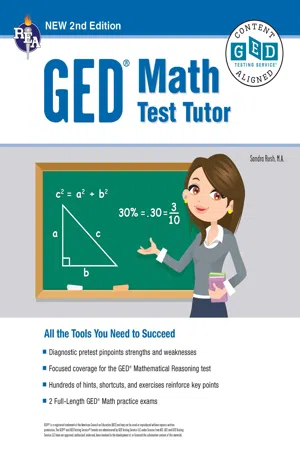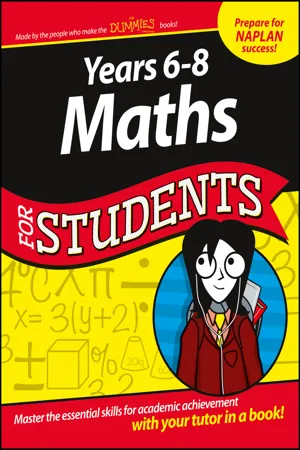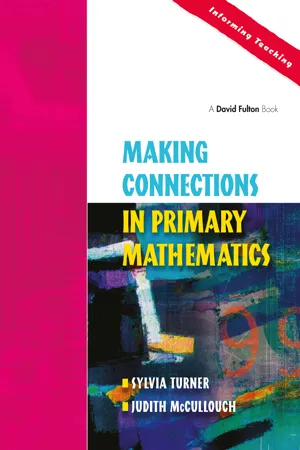Mathematics
Figures
In mathematics, "figures" refer to geometric shapes or forms, such as circles, squares, triangles, and other polygons. These shapes are defined by their specific attributes, such as sides, angles, and dimensions. Figures are often used in geometry to study properties, relationships, and measurements of these shapes.
Written by Perlego with AI-assistance
Related key terms
5 Key excerpts on "Figures"
- eBook - ePub
The Learning and Teaching of Geometry in Secondary Schools
A Modeling Perspective
- Pat Herbst, Taro Fujita, Stefan Halverscheid, Michael Weiss(Authors)
- 2017(Publication Date)
- Routledge(Publisher)
p.48 2 GEOMETRIC Figures AND THEIR REPRESENTATIONS 2.1. IntroductionThe notion of geometric figure, while defined loosely as well as restrictedly by Euclid (“14. A figure is that which is contained by any boundary or boundaries”, Euclid, 1956, p. 153), is central to Euclid’s Elements : Postulates enable possible figure constructions, and propositions assert properties of those Figures or demonstrate that other Figures can be constructed. Later expositions of geometric knowledge have varied in the extent to which they center on the notion of figure, with modern treatises either making figure a centerpiece as an application of set theory (“by figure we mean a set of points”, Moise, 1974, p. 37) or making figure a derived notion within a more general consideration of geometry as the study of transformations of space onto itself (see for example Guggenheimer, 1967; see also Jones, 2002; Usiskin, 1974).The notion of figure has also played a crucial role in scholarship on the teaching and learning of geometry (e.g., Duval, 1995; Fischbein, 1993). This chapter considers how scholarship from various disciplines has influenced our community’s thinking about geometric Figures. It brings perspectives from mathematics and mathematicians, from the history and philosophy of mathematics, from cognitive science and semiotics, from technology and from mathematics education proper. Influenced by those perspectives we elaborate on the role of the geometric figure in geometry teaching and learning.We articulate some conceptions of figure related to its various representations in the context of making a curricular proposal on which to found research and development: To conceptualize the study of geometry in secondary schools as a process of coming to know Figures as mathematical models of the experiential world. By this we mean that the study of geometry in secondary school could be seen as the development and use of conceptions of figure for students to make a particular kind of sense of their experiences with space and shape in the world: A sense-making akin to that of an applied mathematician creating a model of a real world phenomenon. This assertion clearly is not meant as a statement of fact—we have not ascertained that such a position is articulated by a majority of curricular offerings in geometry. Nor do we intend it prescriptively or ideologically, as a statement of how we think curriculum ought to be designed. Rather, the assertion is meant as the proposition of a perspective from which to read existing research: If the study of geometry were to be conceived of in that way, what would the existing research have to say about it? The assertion is also intended as the proposal of a large design research project within which to ask further research questions: If the study of geometry could be conceived of in that way, what could it look like, what could it make possible as far as students’ thinking and learning, what knowledge might it require of teachers, and what demands and tensions might it pose for teachers? - eBook - ePub
- Sandra Rush(Author)
- 2017(Publication Date)
- Research & Education Association(Publisher)
6The Shape of Things
This chapter is about geometry. Every day, you see many things that have to do with geometry and you use geometric principles, even though you don’t think of them as geometry. Tires are circles, and they had better be attached at the exact center of the circle to function properly. Honeycombs are made up of hexagons (six-sided Figures). Even the truss on a bridge is a trapezoid, and bridges are made up of many triangles because the triangles create rigidity.A lot of understanding geometry is knowing the words that describe a shape. Pay particular attention to the definitions in the following sections, although they are words you probably already know.Two words that pertain to all two-dimensional closed geometric Figures are perimeter and area. (Closed means all the corners are connected.) The perimeter is the distance around a figure, or the sum of the lengths of all of its sides. A typical perimeter is a fence around a plot of land. Area is a term used for the space enclosed by any closed figure. It is expressed in square units (in2 , ft2 , and so forth) and is found by various formulas, some of which are on the GED® test formula sheet. Typical areas that we see every day are a rug or a plot of land enclosed by a fence.Lines and Angles
Geometric shapes have everything to do with lines and angles, so you must understand them first. Even circles, which are not made up of straight lines or angles, still have straight lines and angles within them that tell, for example, the size of the circle as well as parts of the circle.A line actually goes on forever in both directions, or we say, “It goes on to infinity (∞) in both directions.” If we want to concentrate on a part of a line, we call that a line segment, and we show which line segment we mean by stating its endpoints. So if we are interested in a line that goes from the 1-inch to the 5-inch measure, we mean a 4-inch line segment. A line segment, since it has a definite measure, has a midpoint, which is exactly halfway between the endpoints. A ray - eBook - ePub
- (Author)
- 0(Publication Date)
- For Dummies(Publisher)
orientation — if you twist a square around, the shape is still a square, even if it looks like a diamond. Regardless of how big a shape is or which way around you draw it, a shape’s properties and name stay the same.You also need to know the difference between two-dimensional and three-dimensional shapes. The ‘D’ in a 3D movie stands for ‘dimensions’. The dimensions make the movie seem as if everything isn’t just flat on a screen but has depth. Similarly, in maths, two-dimensional objects are flat (you can draw them on paper) and three-dimensional Figures come out of the page.Sussing out shapes you know
You need to recognise the following two-dimensional — or flat — shapes, which I also show in Figure 11.1 :- Square: A shape with four equal-length straight sides arranged at right-angles to each other.
- Rectangle: A shape with four straight sides at right-angles to each other. The sides aren’t necessarily all the same length, but sides opposite each other are always the same length.
- Triangle: A shape with three straight sides. As you progress with maths, most of the geometry you do is based on triangles.
- Circle: This is the only curved shape you really need to know about. The technical definition is ‘a shape with all of the points a fixed distance from the centre’, but you’ll recognise a circle when you see one.
Figure 11-1 : A square, a rectangle, a triangle and a circle.Three-dimensional Figures are objects that don’t lie flat. The following four three-dimensional Figures, which I show in Figure 11.2 , are closely linked to the four major two-dimensional shapes that I describe in the preceding list:- Cube: The shape of a normal die. Each of a cube’s sides is a square, and all of the edges are the same length.
- Cuboid:
- eBook - ePub
Fostering Children's Mathematical Power
An Investigative Approach To K-8 Mathematics Instruction
- Arthur Baroody, Arthur J. Baroody, Ronald T. Coslick(Authors)
- 1998(Publication Date)
- Routledge(Publisher)
chapter 16 . In brief, “children who develop a strong sense of spatial relationships and who master the concepts and language of geometry are better prepared to learn number and measurement ideas as well as other advanced topics “ (NCTM, 1989, p. 48).In this chapter, we examine the value of geometry and the nature of geometric learning (Unit 14 • 1) and then focus on how geometry can be taught in a stimulating manner (Unit 14 • 2).What the NCTM Standards SayGrades K-4 “In grades K-4, the mathematics curriculum should include two- and three-dimensional geometry so that students can:- describe, model, draw, and classify shapes;
- investigate and predict the results of combining, subdividing, and changing shapes;
- develop spatial sense;
- relate geometric ideas to number and measurement ideas;
- recognize and appreciate geometry in their world” (p. 48).
- identify, describe, compare, and classify geometric Figures;
- visualize and represent geometric Figures with special attention to developing spatial sense;
- explore transformation of geometric Figures;
- represent and solve problems using geometric models;
- understand and apply geometric properties and relationships;
- develop an appreciation of geometry as a means of describing the physical world” (p. 112).
Both literally and figuratively, we live in a geometric world. We encounter parallel lines on ruled paper, printed pages, railroad tracks, and so forth; and we think about our world—including our personal relationships—in terms of geometric analogies (see Figure 14.1 - eBook - ePub
- Sylvia Turner, Judith McCulloch(Authors)
- 2017(Publication Date)
- Routledge(Publisher)
CHAPTER 3Shape, space and measures
SOME KEY CONNECTIONS WITHIN AND ACROSS ATTAINMENT TARGETS• Patterns in number and shape.• Properties of number and shape.• Conservation in measurement and representation of numbers.• Transformation in shape and numbers through equivalence.• Proof in shape and number.• Transitivity in measures and number.• 2D and 3D shapes.• Abstraction of 2D representations and reality of 3D representation.Using and applying shape, space and measures
Introduction
There are many connections from using and applying shape, space and measures to other aspects of mathematics. Understanding the concept of pattern is more accessible visually than through notation. Similarly mathematical reasoning which involves communicating mathematically and explaining, making generalisations and proof is often more easily understood through shape and space than number as it provides immediate opportunities to accommodate a range of learning styles. Children can move shapes around, draw patterns, look at their own visual representations as well as those offered to them, and become involved with investigational activities working individually or in groups. A question using numbers, such as why an even number can be written as the sum of two odd numbers, may have to go through an additional stage of developing representations to match the notation. It is interesting to note that rarely would a teacher start work on shape by just talking about it and not use resources, as sometimes can be the case with number work.Using and applying measurement has a clear but tenuous link with shape and space. Shape, space and measures relate to geometric problems. If considering application of measurement there is a tendency to relate it only to the dimensions of shape and space that often leads on to everyday life projects, e.g. calculating the costs of activities such as redecorating a bedroom or packaging solutions. Children, however, need to consider the concept of measurement and its connection to shape and space, not merely how to calculate working with the dimensions of shape and space. Why do we use different units of measurement? What is the equivalence between these different units? How appropriate are those units to problems that need to be solved?
Learn about this page
Index pages curate the most relevant extracts from our library of academic textbooks. They’ve been created using an in-house natural language model (NLM), each adding context and meaning to key research topics.




